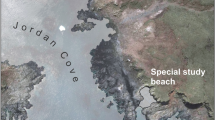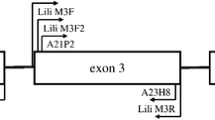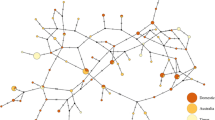Abstract
Although the number of studies focusing on the major histocompatibility complex (MHC) in non-model vertebrates is increasing, results are often contradictory, and the structure of MHC is still poorly understood in wild species. Here, we describe the structure and diversity of exon 3 of MHC class I in a passerine bird, the Scarlet Rosefinch (Carpodacus erythrinus). Using capillary electrophoresis single-strand conformation polymorphism, we identified 82 different MHC class I variants in one Rosefinch population nesting at one site in the Czech Republic. Thus far, this is the highest intra-populational MHC class I variation observed in birds. We have not found support for ‘minimal essential’ MHC in this species since individuals exhibited between three and nine different exon 3 sequences, indicating that there may be at least five amplified MHC class I genes. By cloning, we obtained and analysed 29 exon sequences and found that all of them could be translated into potentially functional proteins. We also show that strong positive selection appears to be acting mainly, but not only, on previously described antigen-binding sites in MHC class I genes. Furthermore, our results indicate that recombination has played an important role in generating genetic diversity of these genes in the Scarlet Rosefinch; we discuss the significance of this extremely high genetic diversity in light of the life history traits of this species, such as long-distance migration.



Similar content being viewed by others
References
Abbas AK, Lichtman AH, Pober JS (1994) Cellular and molecular immunology. W. B. Saunders Company, Philadelphia
Aguilar A, Garza JC (2007) Patterns of historical balancing selection on the salmonid major histocompatibility complex class II beta gene. J Mol Evol 65:34–43. doi:10.1007/s00239-006-0222-8
Albrecht T (2004) Edge effect in wetland-arable land boundary determines nesting success of scarlet rosefinches Carpodacus erythrinus in the Czech Republic. Auk 121:361–371. doi:10.1642/0004-8038(2004)121[0361:EEIWLB]2.0.CO;2
Albrecht T, Schnitzer J, Kreisinger J, Exnerová A, Bryja J, Munclinger P (2007) Extrapair paternity and the opportunity for sexual selection in long-distant migratory passerines. Behav Ecol 18:477–486. doi:10.1093/beheco/arm001
Alcaide M, Edwards SV, Negro JJ (2007) Characterization, polymorphism, and evolution of MHC Class II B genes in birds of prey. J Mol Evol 65:541–554. doi:10.1007/s00239-007-9033-9
Amills M, Ramírez O, Tomás A, Obexer-Ruff G, Vidal O (2008) Positive selection on mammalian MHC-DQ genes revisited from a multispecies perspective. Genes Immun 9:651–658. doi:10.1038/gene.2008.62
Anisimova M, Nielsen R, Yang Z (2003) Effect of recombination on the accuracy of the likelihood method for detecting positive selection at amino acid sites. Genetics 164:1229–1236
Bjorkman PJ, Saper MA, Samraoui B, Bennett WS, Strominger JL, Wiley DC (1987) Structure of human class I histocompatibility antigen, HLA-A2. Nature 329:506–512. doi:10.1038/329506a0
Bonneaud C, Sorci G, Morin V, Westerdahl H, Zoorob R, Wittzell H (2004) Diversity of MHC class I and IIB genes in house sparrows (Passer domesticus). Immunogenetics 55:855–865. doi:10.1007/s00251-004-0648-3
Bonneaud C, Chastel O, Federici P, Westerdahl H, Sorci G (2006a) Complex MHC-based mate choice in a wild passerine. Proc R Soc 273:1111–1116. doi:10.1098/rspb.2005.3325
Bonneaud C, Pérez-Tris J, Federici P, Chastel O, Sorci G (2006b) Major histocompatibility alleles associated with local resistance to malaria in a passerine. Evolution Int J Org Evolution 60:383–389
Bryja J, Galan M, Charbonnel N, Cosson J-F (2005) Analysis of major histocompatibility complex class II gene in water voles using capillary electrophoresis-single stranded conformation polymorphism. Mol Ecol Notes 5:173–176. doi:10.1111/j.1471-8286.2004.00855.x
Burri R, Niculita-Hirzel H, Roulin A, Fumagalli L (2008) Isolation and characterization of major histocompatibility complex (MHC) class II B genes in teh Barn owl (Aves: Tyto alba). Immunogenetics 60:543–550. doi:10.1007/s00251-008-0308-0
Cramp S, Simmons KEL, Perrins CM (eds) (1977-1994) The birds of the Western Palearctic. Oxford University Press, Oxford
Edwards SV, Wakeland EK, Potts WK (1995) Contrasting histories of avian and mammalian MHC genes revealed by class II B genes of songbirds. Proc Natl Acad Sci U S A 92:12200–12204. doi:10.1073/pnas.92.26.12200
Edwards SV, Chesnut K, Satta Y, Wakeland EK (1997) Ancestral polymorphism of Mhc Class II genes in mice: implications for balancing selection and the mammalian molecular clock. Genetics 146:655–668
Fitzpatrick S (1994) Colourful migratory birds: evidence for a mechanism other than parasite resistance for the maintenance of ‘good genes’ sexual selection. Proc R Soc Lond B Biol Sci 257:155–166. doi:10.1098/rspb.1994.0109
Freeman-Gallant CR, Johnson EM, Saponara F, Stanger M (2002) Variation at the major histocompatibility complex in Savannah sparrows. Mol Ecol 11:1125–1130. doi:10.1046/j.1365-294X.2002.01508.x
Garrigan D, Edwards SV (1999) Polymorphism across an exon-intron boundary in an avian Mhc class II B gene. Mol Biol Evol 16:1599–1606
Goüy de Bellocq J, Charbonnel N, Morand S (2008) Coevolutionary relationship between helminth diversity and Mhc class II polymorphism in rodents. J Evol Biol 21:1144–1150. doi:10.1111/j.1420-9101.2008.01538.x
Hall TA (1999) BioEdit: a user-friendly biological sequence alignment editor and analisis program for Windows 95/98/NT. Nucleic Acids Symp Ser 41:95–98
Hansson B, Richardson DS (2005) Genetic variation in two endangered Acrocephalus species compared to a widespread congener: estimates based on functional and random loci. Anim Conserv 8:83–90. doi:10.1017/S1367943004001878
Hess CM, Edwards SV (2002) The evolution of major histocompatibility genes in birds. Bioscience 52:423–431. doi:10.1641/0006-3568(2002)052[0423:TEOTMH]2.0.CO;2
Hess CM, Gasper J, Hoekstra H, Hill C, Edwards SV (2000) MHC class II pseudogene and genomic signature of a 32-kb cosmid in the House Finch (Carpodacus mexicanus). Genome Res 10:13–23. doi:10.1101/gr.10.5.613
Hosomichi K, Shiina T, Suzuki S, Tanaka M, Shimizu S, Iwamoto S, Hara H, Yoshida Y, Kulski JK, Inoko H, Hanzawa K (2006) The major histocompatibility complex (Mhc) class IIB region has greater genomic structural flexibility and diversity in the quail than the chicken. BMC Genomics 7:322–335. doi:10.1186/1471-2164-7-322
Hughes AL, Yeager M (1998) Natural selection at major histocompatibility complex loci of vertebrates. Annu Rev Genet 32:415–435. doi:10.1146/annurev.genet.32.1.415
Hughes CR, Miles S, Walbroehl JM (2008) Support for the minimal essential MHC hypothesis: a parrot with a single, highly polymorphic MHC class II B gene. Immunogenetics 60:219–231. doi:10.1007/s00251-008-0287-1
Indovina P, Megiorni F, Fontemaggi G, Coni P, Mora B, Mazzilli MC (2001) Absence of in vivo DNA-Protein interactions in the DQA2 and DQB2 promoter regions. Hum Immunol 62:504–508. doi:10.1016/S0198-8859(01)00236-1
Jarvi SI, Goto RM, Gee GF, Briles WE, Miller MM (1999) Identification, inheritance, and linkage of B-G-like and MHC class I genes in cranes. Am Genet Assoc 90:152–159
Kaufman J (1999) Co-evolving genes in MHC haplotypes: the ‘rule’ for nonmammalian vertebrates? Immunogenetics 50:228–236. doi:10.1007/s002510050597
Kaufman J, Salamonsen J, Flajnik M (1994) Evolutionary conservation of MHC class I and class II molecules-different yet the same. Semin Immunol 6:411–424. doi:10.1006/smim.1994.1050
Kaufman J, Völk H, Wallny H (1995) A „minimal essential MHC“ and an „unrecognized MHC“: two extremes in selection for polymorphism. Immunol Rev 143:63–88. doi:10.1111/j.1600-065X.1995.tb00670.x
Kaufman J, Jacob J, Shaw I, Walker B, Milne S, Beck S, Salomonsen J (1999) Gene organisation determines evolution of function in the chicken MHC. Immunol Rev 167:101–117. doi:10.1111/j.1600-065X.1999.tb01385.x
Klein J (1986) Natural history of the major histocompatibility complex. Wiley, New York
Klein J, Sato A, Nagl S, O'h Uigin C (1998) Molecular trans-species polymorphism. Annu Rev Ecol Syst 29:1–21. doi:10.1146/annurev.ecolsys.29.1.1
Koch M, Camp S, Collen T, Avila D, Salomonsen J, Wallny HJ, van Hateren A, Hunt L, Jacob JP, Johnston F, Marston DA, Shaw I, Dunbar PR, Cerundolo V, Jones EY, Kaufman J (2007) Structures of an MHC class I molecule from B21 chickens illustrate promiscuous peptide binding. Immunity 27:885–899. doi:10.1016/j.immuni.2007.11.007
Kosakovsky Pond SL, Frost SDW (2005) Not so different after all: a comparison of methods for detecting amino acid sites under selection. Mol Biol Evol 22:1208–1222. doi:10.1093/molbev/msi105
Kosakovsky Pond SL, Frost SDW, Muse SV (2005) HyPhy: hypothesis testing using phylogenies. Bioinformatics 21:676–679. doi:10.1093/bioinformatics/bti079
Kosakovsky Pond SL, Posada D, Gravenor MB, Woelk CH, Frost SDW (2006) Automated phylogenetic detection of recombination using a genetic algorithm. Mol Biol Evol 23:1891–1901. doi:10.1093/molbev/msl051
Loiseau C, Zoorob R, Garnier S, Birard J, Federici P, Julliard R, Sorci G (2008) Antagonistic effects of a MHC class I allele on malaria-infected house sparrows. Ecol Lett 11:258–265. doi:10.1111/j.1461-0248.2007.01141.x
Mesa CM, Thulien KJ, Moon DA, Veniamin SM, Magor KE (2004) The dominant MHC class I gene is adjacent to the polymorphic TAP2 gene in the duck, Anas platyrhynchos. Immunogenetics 56:192–203. doi:10.1007/s00251-004-0672-3
Miller HC, Lambert DM (2004) Gene duplication and gene conversion in class II MHC genes of New Zealand robins (Petroicidae). Immunogenetics 56:178–191
Miller MM, Goto RM, Bernot A, Zoorob R, Auffray C, Bumstead N, Briles WE (1994) Two Mhc class I and two Mhc class II genes map to the chicken Rfp-Y system outside the B complex. Proc Natl Acad Sci U S A 91:4397–4401. doi:10.1073/pnas.91.10.4397
Miller HC, Belov K, Daugherty CH (2006) MHC Class I genes in the Tuatara (Sphenodon spp.): evolution of the MHC in an ancient reptilian order. Mol Biol Evol 23:949–956. doi:10.1093/molbev/msj099
Pérez-Tris J, Bensch S (2005) Dispersal increases local transmission of avian malarial parasites. Ecol Lett 8:838–845. doi:10.1111/j.1461-0248.2005.00788.x
Poláková R, Vyskočilová M, Martin JF, Mays HL Jr, Hill GE, Bryja J, Schnitzer J, Albrecht T (2007) A multiplex set of microsatellite markers for the Scarlet Rosefinch (Carpodacus erythrinus). Mol Ecol Notes 7:1375–1378. doi:10.1111/j.1471-8286.2007.01892.x
Reusch TBH, Schaschl H, Wegner KM (2004) Recent duplication and inter-locus gene conversion in major histocompatibility class II-genes in a teleost, the three-spined stickleback. Immunogenetics 56:427–437. doi:10.1007/s00251-004-0704-z
Richardson DS, Westerdahl H (2003) MHC diversity in two Acrocephalus sepcies: the outbred Great reed warbler and the inbred Seychelles warbler. Mol Ecol 12:3523–3529. doi:10.1046/j.1365-294X.2003.02005.x
Richardson DS, Komdeur J, Burke T, von Schantz T (2004) MHC-based patterns of social and extra-pair mate choice in the Seychelles warbler. Proc R Soc Lond B Biol Sci 272:759–767. doi:10.1098/rspb.2004.3028
Shaw I, Powell TJ, Marston DA, Baker K, van Hateren A, Riegert P, Wiles MV, Milne S, Beck S, Kaufman J (2007) Different evolutionary histories of the two classical class I genes BF1 and BF2 illustrate drift and selection within the stable MHC haplotypes of chickens. J Immunol 178:5744–5752
Shiina T, Shimizu S, Hosomichi K, Kohara S, Watanabe S, Hanzawa K, Beck S, Kulski JK, Inoko H (2004) Comparative genomic analysis of two avian (Quail and Chicken) MHC regions. J Immunol 172:6751–6763
Shiina T, Hosomichi K, Hanzawa K (2006) Comparative genomics of the poultry major histocompatibility complex. Anim Sci J 77:151–162. doi:10.1111/j.1740-0929.2006.00333.x
Shum BP, Rajalingam R, Magor KE, Azumi K, Carr WH, Dixon B, Stet RJ, Adkison MA, Hedrick RP, Parham P (1999) A divergent non-classical class I gene conserved in salmonids. Immunogenetics 49:479–490. doi:10.1007/s002510050524
Spottiswoode C, Møller AP (2004) Extra-pair paternity, migration and breeding synchrony in birds. Behav Ecol 15:41–57
Strand T, Westerdahl H, Höglund J, Alatalo RV, Siitari H (2007) The Mhc class II of the Black grouse (Tetrao tetrix) consists of low numbers of B and Y genes with variable diversity and expression. Immunogenetics 59:725–734. doi:10.1007/s00251-007-0234-6
van Oosterhout C, Joyce DA, Cummings SM (2006) Evolution of MHC class IIB in the genome of wild and ornamental guppies, Poecilia reticulata. Heredity 97:111–118. doi:10.1038/sj.hdy.6800843
Wallny H, Avila D, Hunt L, Powell T, Riegert P, Salomonsen J, Skjodt K, Vainio O, Vilbois F, Wiles M, Kaufman J (2006) Peptide motifs of the single dominantly expressed class I molecule explain the striking MHC-determined response to Rous sarcoma virus in chicken. Proc Natl Acad Sci U S A 103:1434–1439. doi:10.1073/pnas.0507386103
Westerdahl H, Wittzell H, von Schantz T (1999) Polymorphism and transcription of MHC class I genes in a passerine bird, the great reed warbler. Immunogenetics 49:158–170. doi:10.1007/s002510050477
Westerdahl H, Witzel H, von Schantz T (2000) MHC diversity in two passerine birds: no evidence for a minimal essential MHC. Immunogenetics 52:92–100. doi:10.1007/s002510000256
Westerdahl H, Wittzell H, von Schantz T, Bensch S (2004) MHC class I typing in a songbird with numerous loci and high polymorphism using motif-specific PCR and DGGE. Heredity 92:534–542. doi:10.1038/sj.hdy.6800450
Westerdahl H, Waldenström J, Hansson B, Hasselquist D, von Schantz T, Bensch S (2005) Associations between malaria and MHC genes in a migratory songbird. Proc R Soc Lond B Biol Sci 272:1511–1518. doi:10.1098/rspb.2005.3113
Wilson DJ, McVean G (2006) Estimating diversifying selection and functional constraint in the presence of recombination. Genetics 172:1411–1425. doi:10.1534/genetics.105.044917
Wittzell H, Bernot A, Auffray C, Zoorob R (1999a) Concerted evolution of two Mhc class II B loci in pheasants and domestic chicken. Mol Biol Evol 16:479–490
Wittzell H, Madsen T, Westerdahl H, Shine R, von Schantz T (1999b) MHC variation in birds and reptiles. Genetica 104:301–309. doi:10.1023/A:1026421607089
Worley K, Gillingham M, Jensen P, Kennedy LJ, Pizzari T, Kaufman J, Richardson DS (2008) Single locus typing of MHC class I and class II B loci in a population of red jungle fowl. Immunogenetics 60:233–247. doi:10.1007/s00251-008-0288-0
Xia C, Hu T, Yang T, Wang L, Xu G, Lin C (2005) cDNA cloning, genomic structure and expression analysis of the goose (Anser cygnoides) MHC class I gene. Vet Immunol Immunopathol 107:291–302. doi:10.1016/j.vetimm.2005.05.005
Yang Z (1997) PAML: a program package for phylogenetic analysis by maximum likelihood. Comput Appl Biosci 13:555–556
Yang Z, Swanson WJ, Vacquier VD (2000) Maximum-likelihood analysis of molecular adaptation in abalone sperm lysin reveals variable selective pressures among lineages and sites. Mol Biol Evol 17:1446–1455
Yang Z, Wong WSW, Nielsen R (2005) Bayes empirical Bayes inference of amino acid sites under positive selection. Mol Biol Evol 22:1107–1118. doi:10.1093/molbev/msi097
Acknowledgements
We thank Pavel Munclinger, Michal Vinkler, Jan Schnitzer and Radka Poláková, for their help in the field. Thanks to Anna Bryjová and Dagmar Čížková for their valuable advice in the laboratory. We are very grateful to Heidi C. Hauffe for improving the English and two anonymous referees for critical comments on the manuscript. This study was funded by the Grant Agency of the Academy of Sciences of the Czech Republic (project no. IAA600930608), the Grant Agency of the Czech Rep. (project no. 206/06/0851) and by the Ministry of Education of the Czech Rep., whose Research Centre no. LC06073 and Long-term Research Plan (no. MSM 0021620828) to the Charles University in Prague formed a framework for a part of this study.
Author information
Authors and Affiliations
Corresponding author
Additional information
The sequence data described in this paper are accessible in GenBank data library under accession numbers FJ392762–FJ392790.
Rights and permissions
About this article
Cite this article
Promerová, M., Albrecht, T. & Bryja, J. Extremely high MHC class I variation in a population of a long-distance migrant, the Scarlet Rosefinch (Carpodacus erythrinus). Immunogenetics 61, 451–461 (2009). https://doi.org/10.1007/s00251-009-0375-x
Received:
Accepted:
Published:
Issue Date:
DOI: https://doi.org/10.1007/s00251-009-0375-x




